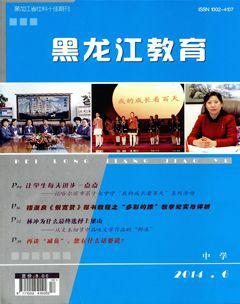Unit 11 Across Generations Lesson 3 Structure教學設計及反思
+趙錦秀
教學內容
本節課所授內容是2013年教育部審定的,由教育科學出版社出版的義務教育教科書(五·四學制)英語七年級下冊第十一單元第三課,本節課是一節語法課,要求學生學會區分和運用must, have to, dont have to, must not。通過本課的學習,使學生熟練運用這4個詞進行本單元的話題討論。
教學目標
(1) 知識目標:
詞匯: environment, ourselves, stair, anyone
句型: Parents must try to understand their children more.
She has to study for the final exams.
I dont have to go to school on Sundays.
I mustnt be late for school.
(2) 能力目標:
學會區分和運用must, have to, dont have to, must not, 并能用這4個詞進行本單元的話題討論。
(3) 情感目標:
通過活動,讓學生學會善于與父母、老師和同學溝通,敢于表達自己的觀點和態度,同時也學會尊重他人的觀點。
教學重點、難點:
教學重點:區分和運用must, have to, dont have to, must not。
教學難點:準確使用dont have to和must not及have to有人稱、數和時態的變化。
教學過程:
Step1 Lead in
T: All the parents love their children and they expect to understand their children more, right?
Ss: Yes.
T: Then, please choose the correct answer. Parents _____ try to understand their children more. ( must / have to)
Ss: Must.
T: Thats right. “must”表示“必須”“一定要”,強調說話人的主觀意愿,多指現在或將來的情況。
Ss: Why cant we use “have to” in this sentence?
T: If you use “have to”, it means parents dont care for their children but others make them do this. Thats wrong. “have to” 表示“不得不”“只好”,表示客觀上的必要性。此句若用了“have to”,則表示父母本不關心孩子,只是外界或他人要求他們這樣做,他們不得不做,所以選“have to”不合情理。
T: Now, look at this one. Please choose the correct answer. Change the word forms if necessary. She _____ study for the final exams. ( must / have to)
Ss: Have to.
T: You are wrong. Pay attention to “she”.
Ss: Has to.
T: Thats right. 注意:have to有人稱、數和時態的變化,而must則沒有人稱、數和時態的變化。Why cant we use “must” in this sentence?
Ss: Because the final exams are coming and she wants to get a good mark. Though she wants to play, she still studies for the final exams.
T: Well done.
Step2 New words
T: First, guess the meaning of the phrases, working environment, school environment, family environment and friendly environment.
Ss:工作環境、學校環境、家庭環境和……(最后一個學生猜測困難,教師可以給出提示或答案“友好氛圍”。)
T: Then, look at this sentence. Please choose the correct answer. We _____ protect the environment for future generation. ( must / have to)
Ss: Must.
T: Right. Please explain the reason.
Ss: We all hope to have a good environment. We all do it actively to protect the environment.
T: Good job. Then, look at the sentences.
We ______do our homework ourselves. ( must / have to)
The elevator is broken, so I ________ climb the stairs. (must / have to)
Without anyone knowing, I _____find out the truth myself.( must / have to)
(設計意圖:用同樣的方式講解其他單詞,可以讓學生更清楚這些單詞的用法及must和have to的區別,并準確地應用。)
Step3 Structure
T: Watch the two sentences carefully and find the difference between “dont have to” and “mustnt”.
I dont have to go to school on Sundays.
I mustnt be late for school.
Ss: 第一句是“我周日不必上學”,第二句是“我一定不要上學遲到”。
T:Good. “mustnt”譯為“不得”“一定不要”,而“dont have to”譯為“不必”“沒必要”,第一句是周日休息所以不必上學,而第二句上學不得遲到是規定,是必須執行的。
T: Then,complete Exercise C.
(設計意圖:讓學生通過觀察,總結出兩個詞的區別和具體用法,然后進行鞏固練習。)
Step4 Exercises
T: First, finish Exercise A and Exercise B. Then check out the answers.
endprint
Ss: (Tell the answers one by one.)
補充練習:
Fill in the blanks with must, have to, dont have to and mustnt. Change the word forms if necessary.
1. We ________remember the date of the next meeting.
2. I _________ tell him the truth at last.
3. Susan _________ go to the station this tomorrow.
4. He _________ go to work on Sundays.
5. When the traffic lights are red, the people ________ cross the street.
6. Were going to eat out. We _______ cook dinner.
7. Amy ________ study yesterday because she has a test today.
8. You have a cold, so you _______ go out to play with your friends.
(設計意圖:通過補充練習,除了讓學生能夠準確選詞外,還要注意用have to 和dont have to 的時候,要考慮人稱、數和時態的變化。)
Step5 Discuss in groups
T: Work and discuss in groups of four. First, you can choose a topic about your parents and your classmates that you understand well. Then, you must use the four words “must, have to, dont have to and mustnt” to make sentences and write them down. Finally, one or two of the groups show their sentences in class.
Topic: Advice that your parents got from their parents.Advice about how to get on well with your parents and your classmates. The school rules.
Ss: Parents must understand that kids are just kids.
We all know we must study hard to succeed in life.
We mustnt play computer games in class.
I have cleaned the classroom. You dont have to clean it.
If you are so busy tomorrow, you wont have to come to my party.
The exam is coming. Liu Chang has to go over again and again.
T: Underline the verbs which are behind the four words “must, have to, dont have to and mustnt”. What can you find out?
Ss: must, have to, dont have to,must not + do
(設計意圖:通過小組活動,讓學生既學會這4個詞的用法,又學會怎樣與父母、老師和同學溝通,敢于表達自己的觀點和態度,同時也學會尊重他人的觀點。)
Step6 Sum up
T: Please sum up what we have learned today. You can speak in Chinese.
Ss: 不同點:“must”表示“必須”“一定要”,強調說話人的主觀意愿,多指現在或將來的情況;“have to” 表示“不得不”“只好”,表示客觀上的必要性; “mustnt”譯為“不得”“一定不要”,而“dont have to”譯為“不必”“沒必要”; have to和dont haveto有人稱、數和時態的變化,而must和mustnt則沒有人稱、數和時態的變化。共同點:其后都接動詞原形。
T: Perfect!
(設計意圖:由學生來總結本課知識點的具體用法、重點和難點及注意事項,可以更好地了解學生的掌握情況,為二次備課做好準備工作。)
Step7 Homework
整理小組討論的話題,寫出你用這4個詞可以全面了解全班同學的語法掌握情況,同時,也可以用選擇好的編題對學生進行再次檢測。
設計至少4個題,分別用這4個詞must, have to, dont have to和must not的正確形式填空。
(設計意圖:第一項作業可以全面了解全班學生的語法掌握情況,彌補課堂小組展示時間不足的問題。第二項作業是針對有能力的學生留的,體現分層次作業,同時可以選擇好的編題對學生進行再次檢測。)
板書設計:
Unit 11 Across Generations
Lesson 3 Structure
Parents must try to understand their children more.
She has to study for the final exams.
I dont have to go to school on Sundays.
I mustnt be late for school.
Note:must, have to, dont have to,must not + do
教學反思:
本課是語法教學,一般來說學生在課堂上會感到枯燥無味、沒有興趣,所以我在課堂上盡量讓學生成為主體,讓學生學會分析、發現、解決問題,并學會總結規律,充分調動他們的學習熱情,同時,小組討論也激發了他們的學習興趣,讓學生體驗合作的樂趣,提高了學生在實際生活中的綜合語言應用能力。在整體設計上,由易到難,分散了難點,把難點各個擊破,讓學生更容易掌握。作業的設計可以全面了解全班學生的語法掌握情況,同時,也可以選擇好的句子經過改編成題后,對學生進行再次檢測。
通過本課教學課后反思,我認為第六步驟和第五步驟互換可能效果更好一些,學生先總結本課知識點、重點和難點,后面的小組討論和小組展示的準確率就可以高一些,也可以讓學生更多地體驗成功的喜悅。另外,有部分小組討論后呈現的句子比較少,因為學生的生活經歷少,在有限的時間內還不能組織太多的句子。所以,可以在組織討論之前,先給學生部分短語,(比如:be late for class, chat in class, keep quiet in the library, be afraid of failure, see the doctor, help parents do housework, understand parents等)然后再讓學生在此基礎上進行討論和補充,比一比哪組補充的多并且語境還好,這樣做的好處是既幫助學生打開了思路,又產生了良性競爭,可以對學生進行潛移默化的情感教育,將品德教育注入日常教學中,則效果會更好。
此外,我認為把第五步驟的總結這4個詞后面接動詞原形的用法,應該放到第一步驟后,讓學生觀察后馬上總結即可。因為情態動詞后接動詞原形不是新的知識點,在六年級時就講解過,所以在預設時,我沒有把它當成難點,在習題的設置上,這4個詞后面接動詞原形的題沒有設置太多。但是在做習題時,尤其是選擇題和綜合題時,這反而成了部分學生的易錯點,他們把這4個詞的用法和一些動詞后加動名詞或動詞不定式的用法混了(非謂語動詞的用法是七年上學期學的)。所以,在課后應該補充一些綜合題來鞏固這一用法。比如,用所給詞的適當形式填空:
1. I enjoy _________ football.(play)
2. We are looking forward to _______ Beijing.(visit)
3. You dont have to _______there early.(get)The shop opens at 9:00a.m.
4. My dad allowed me __________ to the party. (go)
5. I must _________ now. (go) Its 9:00p.m.
6. We mustnt _________ snacks at the movie. (eat)
endprint

